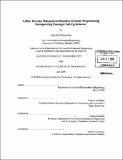| dc.contributor.advisor | Peter P. Belobaba. | en_US |
| dc.contributor.author | Tam, Chiu Fai Wilson | en_US |
| dc.contributor.other | Massachusetts Institute of Technology. Dept. of Civil and Environmental Engineering. | en_US |
| dc.date.accessioned | 2009-03-16T19:28:22Z | |
| dc.date.available | 2009-03-16T19:28:22Z | |
| dc.date.copyright | 2008 | en_US |
| dc.date.issued | 2008 | en_US |
| dc.identifier.uri | http://hdl.handle.net/1721.1/44680 | |
| dc.description | Thesis (S.M.)--Massachusetts Institute of Technology, Dept. of Civil and Environmental Engineering, 2008. | en_US |
| dc.description | Includes bibliographical references (p. 141-147). | en_US |
| dc.description.abstract | Low-fare carriers with simplified and unrestricted fare structures have rapidly grown and captured an important share of demand in the markets they enter, forcing legacy carriers to inevitably simplify their fare structures to avoid distraction of their competitiveness. Consequently, traditional Revenue Management (RM) systems, which assume independent demand of fare classes, have become less effective for legacy carriers in dealing with passengers who tend to purchase the lowest fare available in the absence of distinctions among fare products. This thesis studies two RM optimization algorithms based on dynamic programming, Lautenbacher DP (DPL) and Gallego-Van Ryzin DP (DP-GVR), that aim to control fare class closure using maximum expected revenue. The underlying principle of both DP methods considers the actual arrival pattern of passengers as a Markov decision process. DPL assumes independence of fare classes as do traditional RM methods, and determines which classes should be open for a given time frame. DP-GVR considers the fact that passengers may sell-up or buy down between fare classes, and determines which fare class should be the lowest class open for a given time frame. The goal of this thesis is to evaluate the effectiveness of DPL and DP-GVR when they account for sell-up, using not only arbitrary sell-up assumptions but also estimated sell-up rates. Based on results obtained with the Passenger Origin-Destination Simulator (PODS), we compare the performance of both methods to traditional methods under various competitive settings. Simulation results in a single origin-destination market demonstrate the potential of DPL over traditional methods when high passenger sell-up rates are assumed or estimated. | en_US |
| dc.description.abstract | (cont.) The use of DPL achieves as much as 7.3% revenue improvement over EMSRb with Q-Forecasting at high demand. In contrast, the performance of DP-GVR is weaker especially against an advanced RM method, regardless of sell-up input or estimator used. On the other hand, results from a bigger network illustrate that an airline that practices DP-GVR performs much better against both simple and advanced competing RM methods. We conclude that the performance of the theoretically appealing DPL and DP-GVR depends on the environment in which they are used, the types of passenger sell-up estimator employed, as well as the Revenue Management method applied by the competitor. | en_US |
| dc.description.statementofresponsibility | by Chiu Fai Wilson Tam. | en_US |
| dc.format.extent | 147 p. | en_US |
| dc.language.iso | eng | en_US |
| dc.publisher | Massachusetts Institute of Technology | en_US |
| dc.rights | M.I.T. theses are protected by
copyright. They may be viewed from this source for any purpose, but
reproduction or distribution in any format is prohibited without written
permission. See provided URL for inquiries about permission. | en_US |
| dc.rights.uri | http://dspace.mit.edu/handle/1721.1/7582 | en_US |
| dc.subject | Civil and Environmental Engineering. | en_US |
| dc.title | Airline revenue management based on dynamic programming incorporating passenger sell-up behavior | en_US |
| dc.type | Thesis | en_US |
| dc.description.degree | S.M. | en_US |
| dc.contributor.department | Massachusetts Institute of Technology. Department of Civil and Environmental Engineering | |
| dc.identifier.oclc | 268662078 | en_US |
